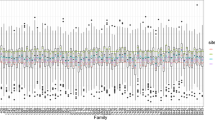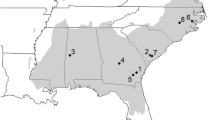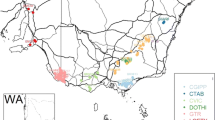Abstract
Forest tree breeders often use single-tree plots, rather than multiple-tree plots, to maximize the number of genotypes tested, increase precision of genetic predictions, and achieve greater genetic gains per unit of time. However, genetically improved individuals are deployed operationally on large tracts of land, as stands, more like multiple-tree plots. This raises the concern that breeding values estimated from single-tree tests are not well correlated with those from large multiple-tree (i.e., block) plots. Comparisons of breeding values from single-tree and multiple-tree plots are largely missing, due to the cost and time associated with establishing and measuring block plots. To address this need, breeding values were evaluated from a second breeding cycle of slash pine that established two polymix single-tree plot trial series and one trial series of full-sib block plots (FSBP). The first polymix series (PMX I) evaluated 140 families, and the second series (PMX II) evaluated 201 polymix families and 43 elite full-sib crosses. Each polymix series had eight sites established in Florida and Georgia, USA. The FSBP series was established at 11 locations in Florida and Georgia with an average of 63 trees per unreplicated block plot for a total of 1141 full-sib families. Breeding values were estimated for each of the families based on fitting a global linear mixed model that included all series. Heritabilities for survival, volume, and rust were 0.15, 0.35, and 0.22, respectively, in PMX I, and 0.11, 0.18, and 0.11, respectively, in PMX II. Correlations between PMX and FSBP series parental breeding value estimates were higher than 0.84, 0.61, and 0.95 for survival, volume, and rust, respectively. Hence, moderate to strong agreement exists for the genetic rankings between single- and multiple-tree plots.




Similar content being viewed by others
References
Adegbidi H, Jokela E, Comerford N (2005) Factors influencing production efficiency of intensively managed loblolly pine plantations in a 1- to 4-year-old chronosequence. For Ecol Manag 218:245–258
Byram T, Lowe W (1986) General and specific combining ability estimates for growth in loblolly pine. Proceedings of the IUFRO conference on breeding theory, progeny testing and seed orchards Oct 12 to 17, Williamsburg, VA, USA, 352–360
Callister A, England N, Collins S (2013) Predicted genetic gain and realised gain in stand volume of Eucalyptus globulus. Tree Genet Genomes 9:361–375
Cotterill P, James J (1984) Number of offspring and plot sizes required for progeny testing. Silvae Genet 33:203–209
DeBell DS, Harrington CA (1997) Productivity of Populus in monoclonal and polyclonal blocks at three spacings. Can J For Res 27:978–985
Dhakal L, White T, Hodge G (1996) Realized genetic gains from slash pine tree improvement. Silvae Genet 45:190–196
Dieters M, White T, Hodge G (1995) Genetic parameter estimates for volume from full-sib tests of slash pine (Pinus elliottii). Can J For Res 25:1397–1408
Dieters M, Hodge G, White T (1996) Genetic parameter estimates for resistance to rust (Cronartium quercuum) infection from full-sib tests of slash pine (Pinus elliottii), modelled as functions of rust incidence. Silvae Genet 45:235–241
Foster GS (1989) Inter-genotypic competition in forest trees and its impact on realized gain from family selection. Proceedings of 20th Southern Forest Tree Improvement Conference, Jun 26-30, Charleston, SC, USA, 21–35
Fox TR (2000) Sustained productivity in intensively managed forest plantations. For Ecol Manag 138:187–202
Gezan SA, White TL, Huber DA (2006) Comparison of experimental designs for clonal forestry using simulated data. For Sci 52:108–116
Gilmour AR, Gogel B, Cullis B, Thompson R (2009) ASReml user guide release 3.0 VSN International Ltd, Hemel Hempstead, UK
Gould PJ, St Clair JB, Anderson PD (2011) Performance of full-sib families of Douglas-fir in pure-family and mixed-family deployments. For Ecol Manag 262:1417–1425
Hodge GR, White TL (1992) Genetic parameter estimates for growth traits at different ages in slash pine and some implications for breeding. Silvae Genet 41:252–262
Huber D, White T, Powell G (2003) Age-five results from the cooperative forest genetics research program slash pine polymix trials. Proceedings of 27th Southern Forest Tree Improvement Conference, Jun 24-27, Oklahoma State University, Stillwater, Oklahoma, USA, 38–43
Jansson G, Danell Ö, Stener L-G (1998) Correspondence between single-tree and multiple-tree plot genetic tests for production traits in Pinus sylvestris. Can J For Res 28:450–458
Johnson GR, Burdon RD (1990) Family-site interaction in Pinus radiata: implications for progeny testing strategy and regionalized breeding in New Zealand. Silvae Genet 39:55–62
Kendall M, Stuart A (1963) The advanced theory of statistics, vol 1. Griffin, London
Lambeth С, Van Buijtenen J, Duke S, McCullough R (1983) Early selection is effective in 20-year-old genetic tests of loblolly pine. Silvae Genet 32:210–215
Lambeth C, Endo M, Wright J (1994) Genetic analysis of 16 clonal trials of Eucalyptus grandis and comparisons with seedling checks. For Sci 40:397–411
Li X, Huber DA, Powell GL, White TL, Peter GF (2007) Breeding for improved growth and juvenile corewood stiffness in slash pine. Can J For Res 37:1886–1893
Loo-Dinkins JA, Tauer C (1987) Statistical efficiency of six progeny test field designs on three loblolly pine (Pinus taeda L.) site types. Can J For Res 17:1066–1070
Lu P, White TL (2004) Determining test and block numbers in consideration of progeny testing quality and cost: an example of half-sib families with RCB design and single-tree plots. For Genet 11:29–44
Pienaar LV, Shiver BD, Rheney JW (1996) Yield prediction for mechanically site-prepared slash pine plantations in the southeastern coastal plain. PMRC Tech Rep 1996–3
Pswarayi IZ (1993) Genetic parameters and selection indices for a population of Pinus elliottii Engelm. var. elliottii. Dissertation, Linacre College, Oxford Univerity, Oxford, UK, pp 13–105
Roth BE, Jokela EJ, Martin TA, Huber DA, White TL (2007) Genotype × environment interactions in selected loblolly and slash pine plantations in the Southeastern United States. For Ecol Manag 238:175–188
Shelbourne CJA (1972) Genotype-environment interaction: its study and implications in forest tree improvement. Proceedings of the IUFRO Joint Genetics Symposium, Japanese Forest Experiment Station IUFRO, Tokyo, Japan, pp 1–28
Stanger TK, Galloway GM, Retief ECL (2011) Final results from a trial to test the effect of plot size on Eucalyptus hybrid clonal ranking in coastal Zululand, South Africa. South For 73:131–135
Staudhammer CL, Jokela EJ, Martin TA (2009) Competition dynamics in pure-versus mixed-family stands of loblolly and slash pine in the southeastern United States. Can J For Res 39:396–409
Vergara R, White TL, Huber DA, Shiver BD, Rockwood DL (2004) Estimated realized gains for first-generation slash pine (Pinus elliottii var. elliottii) tree improvement in the Southeastern United States. Can J For Res 34:2587–2600
White TL (1987) A conceptual framework for tree improvement programs. New For 1:325–342
White TL, Hodge GR (1992) Test designs and optimum age for parental selection in advanced-generation progeny tests of slash pine. Silvae Genet 41:293–302
White TL, Hodge GR, Powell GL (1993) An advanced-generation tree improvement plan for slash pine in the southeastern United States. Silvae Genet 42:359–359
White TL, Adams WT, Neale DB (2007) Forest genetics. Cabi Publishing
Xie C, Fu Y, Yanchuk A (2006) Accuracy of ranking individuals in field tests of different designs: a computer simulation. Silvae Genet 55:70–76
Ye T, Jayawickrama K, St Clair J (2010) Realized gains from block-plot coastal Douglas-fir trials in the northern Oregon Cascades. Silvae Genet 59:29–39
Acknowledgments
This study was made possible by the members of the CFGRP at the School of Forest Resources and Conservation and the Institute of Food and Agricultural Science (IFAS) at the University of Florida. Many people assisted with the trial design, installation, and data collection in the field.
Data archiving statement
We followed the standard Tree Genetics and Genomes policy. Data used in the study came from the CFGRP at the SFRC from the University of Florida. In addition, supplementary information with genotype names and complete field data used in the analyses are included in the Supplemental Files.
Author information
Authors and Affiliations
Corresponding author
Additional information
Communicated by R. Burdon
This article is part of Topical Collection on Breeding
Rights and permissions
About this article
Cite this article
Zhang, J., Peter, G.F., Powell, G.L. et al. Comparison of breeding values estimated between single-tree and multiple-tree plots for a slash pine population. Tree Genetics & Genomes 11, 48 (2015). https://doi.org/10.1007/s11295-015-0870-1
Received:
Revised:
Accepted:
Published:
DOI: https://doi.org/10.1007/s11295-015-0870-1




